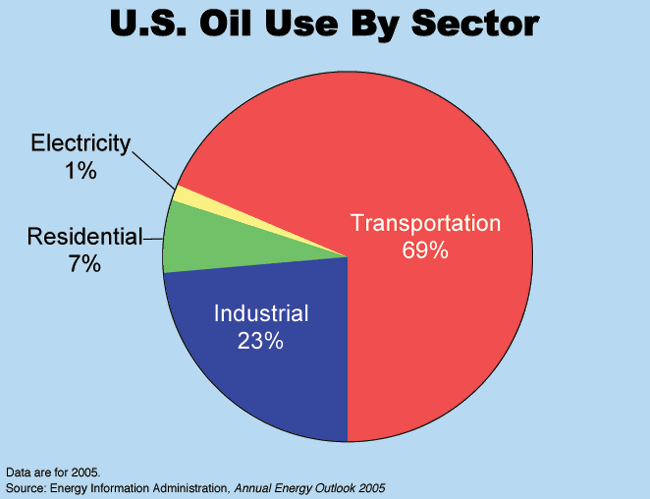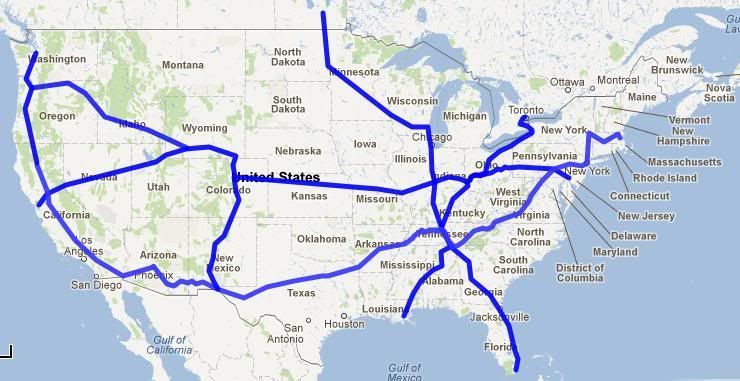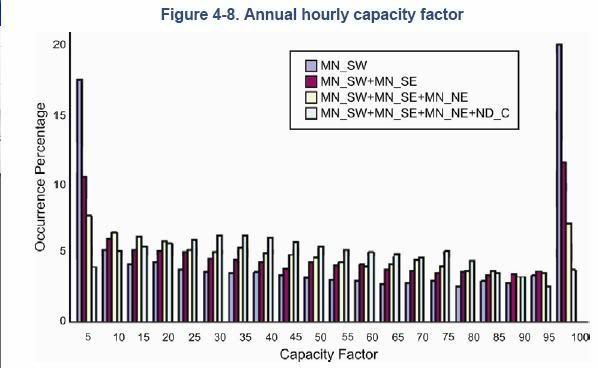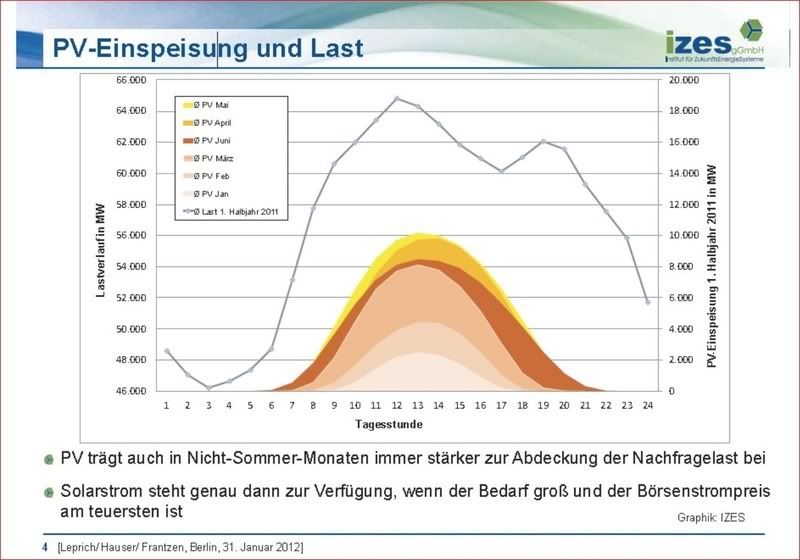(4 pm. – promoted by ek hornbeck)
Burning the Midnight Oil for Living Energy Independence
crossposted from Voices on the Square
 The fundamental objectives of a national Steel Interstate project are two-fold:
The fundamental objectives of a national Steel Interstate project are two-fold:
- Reducing CO2 emissions; and
- Pursuing Energy Independence
The importance of reducing CO2 emissions as a step toward sustainability ought to require no elaboration. It has, of course, been elaborated on in previous Sunday Train essays, and likely will be again, but this Sunday, I will leave it as read. The importance of reducing grossly wasteful oil consumption in long haul freight transport follows directly from the position of the Transport sector as the number two emitter of CO2, and the opportunity presented by long haul electric freight rail to operate at about 20 times the energy efficiency per ton-mile as long haul truck freight.
 The importance of Energy Independence for a sustainable economy may not be as widely understood, but it is as fundamental. For an economic system to be truly sustainable, it must be reproducible. That is, it must be sustainable even if adopted by all countries in the global community. That is why simply importing energy from others to cover the massive gap between our country’s biocapacity and our country’s ecological footprint is not, in fact, sustainable. It cannot be reproduced all around, because then there is no “somewhere else” to go get the energy.
The importance of Energy Independence for a sustainable economy may not be as widely understood, but it is as fundamental. For an economic system to be truly sustainable, it must be reproducible. That is, it must be sustainable even if adopted by all countries in the global community. That is why simply importing energy from others to cover the massive gap between our country’s biocapacity and our country’s ecological footprint is not, in fact, sustainable. It cannot be reproduced all around, because then there is no “somewhere else” to go get the energy.
Indeed, to be truly sustainable, a country such as ours, with twice the average biocapacity per person, ought to have the capacity be a net energy exporting country. So Sustainable Energy Independence is not even an ultimate target: it is the immediate goal to pursue, on the path to the ultimate target.
And with about a fifth of our petroleum consumption going for long haul truck freight, getting even half of our long haul truck freight onto Steel Interstates would cut our petroleum consumption by about a tenth. That is roughly 7% of our oil consumption and up to about 3% of our CO2 emissions (depending on the power source), so its a one-in-fifteen slice of oil independence and a larger than one-in-forty slice of carbon neutrality.
The topic for today is the flipside of the Steel Interstate proposal: the Electricity Superhighways, and how they offer the chance to substantially increase the size of the carbon neutrality slice.
The Steel Interstates: An Overview
 To the right is a map of long haul truck freight, scaled by ton-miles. That is the demand for transport that the Steel Interstate system is targeting.
To the right is a map of long haul truck freight, scaled by ton-miles. That is the demand for transport that the Steel Interstate system is targeting.
Now, rail freight and truck freight each have their own advantages. One of the advantages of truck freight is its flexibility in “first mile” and “last mile” transport. The Steel Interstate does not attempt at the outset to contest this advantage, but rather it plans to take advantage of this flexibility by relying on truck transport for the “first few miles” and “last few miles” of most freight shipments, relying on intermodal transport to collect freight from an origin railhead near the origin and deliver the freight to a destination railhead near the destination. Of course, if the origin and/or destination is equipped with rail facilities, the Steel Interstate can rely on that: but the design goal is that it should not have to.
In order to be competitive with trucking in terms of transit time and schedule reliability, the Steel Interstate corridors offer Rapid Freight Rail paths for time-sensitive shipments. 90mph freight speed limits allows the Steel Interstate to beat a single truck loading dock to loading dock, even though the shipment included the time overhead of marshaling a container onto a steel interstate freight train at the origin railhead and back to a truck for final delivery at the destination railhead.
 The map of Steel Interstates that I display is a notional map. The proposal is to establish one or more Line Development Banks, which will be tasked with developing Steel Interstate corridors to serve specific long haul truck markets, and the Line Development Banks would be responsible for negotiating the actual final alignment with the private railroads that own the right of way.
The map of Steel Interstates that I display is a notional map. The proposal is to establish one or more Line Development Banks, which will be tasked with developing Steel Interstate corridors to serve specific long haul truck markets, and the Line Development Banks would be responsible for negotiating the actual final alignment with the private railroads that own the right of way.
Sustainable Electric Power
A key element of the Steel Interstate system for today’s specific topic is that the design envelope requires that the Steel Interstate corridor be able to be used for long-distance High Voltage DC power transmission corridors, for grid-to-grid power transmission. HVDC power lines can transmit power over 600 miles with only 5% transmission power loss. We do not use them for regional power distribution, since they are ill-suited for transmission of power to multiple points, but they are well suited to the task of connecting regional grids that may have excess sustainable power generation to those that have a demand to consume more sustainable power than they are currently generating.
For example, for Wind Power resources, the notional Steel Interstate corridors include a connection to the existing 460mile HVDC transmission corridor between North Dakota and Minnesota, runs through the Central Plans and Southern Plains wind resources, and connects to the east coast and Great Lakes offshore wind resources. The total wind resource in these areas are many times the present electricity consumption of the United States: indeed, the total wind resource in Kansas alone could provide 75% of US electricity consumption.
Renewable, Sustainable Power and the Baseload Fiction
The imagined bête noire of Windpower to Windpower opponents is that Windpower cannot provide “baseload power”. However, baseload does not exist in reality: it exists as a result of the institutional arrangements we have developed for managing a fossil-fuel powered electrical grid. What exists in reality is a fluctuating total amount of load placed upon the grid. It can be split into predictable demand and unpredictable demand. Predictable demand follows a daily cycle, with different heights depending on a variety of factors ~ expected weather conditions, regular weekday, weekend, holiday weekend, etc. Unpredictable demand is then just the difference between predicted load and actual load, and by its nature it does not follow a regular pattern, since the regularities can be detected and added to the prediction.
Any constant source of power presents a mismatch between load and supply, which has to be compensated for by being able to tap supplies that can be brought online quickly. Even a “normally constant” supply can be divided into predictable supply and unpredictable supply. The predictable supply is generally close to a square wave: supplying the capacity when running, and supplying zero when scheduled to shut down. The unpredictable supply is also close to a square wave, consisting of the shortfalls that occur when the supply is scheduled to be available but there is a problem that prevents it from generating. We could measure the percentage of the time that the supposedly constant power source was not generating power as its “intermittency”, and the percentage of the time that the supposedly constant power source was unexpectedly not generating power as its volatility.
Any independently variable source of power can presents a similar mismatch between load and supply, if the supply does not tend to occur alongside the load. It also can be split into the predictable supply and unpredictable supply. We can
Much of the complaint that Windpower treats it as totally volatile, with the variations in supply treated as if they are totally unpredictable.
 That is, of course, a fairy tail to scare children. The volatility of a single Wind Turbine is quite high. However, the volatility of the total energy supply of wind turbines across a wind farm is substantially lower. First, the average wind across the wind farm is more predictable than the wind at a specific wind turbine. Second, the wind energy across the farm is less variable than the wind energy at a specific turbine. So there is less variability to predict, and that variability is also easier to predict.
That is, of course, a fairy tail to scare children. The volatility of a single Wind Turbine is quite high. However, the volatility of the total energy supply of wind turbines across a wind farm is substantially lower. First, the average wind across the wind farm is more predictable than the wind at a specific wind turbine. Second, the wind energy across the farm is less variable than the wind energy at a specific turbine. So there is less variability to predict, and that variability is also easier to predict.
The same thing applies if there are multiple wind farms spread across a single wind resource, the total electricity supply even less volatile: there is less variability than for an individual wind farm, and its easier to predict the variability than for an individual wind farm. Research shows that the wider the distribution of wind farms across a wind source, the less variability is experienced.
And, here is where the Electricity Superhighways comes in, the same thing applies yet again: the variability of wind power generation across multiple distinct wind resources is even lower, and the predictability of that variability even higher.
This is why establishing an electrical system which required each individual wind farm to store electricity to be able to provide a constant supply is an inefficient design: it is over-correcting, because the variability of total Wind Energy production is substantially less than the variability of Wind Energy production at any individual wind farm.
Natural Energy Storage
The baseload fiction argument relies heavily on a status quo bias. We do not question the system we currently have, but rather take it for granted. We are used to systems with baseload power, so we think of baseload power as if it was natural. But its not: its a consequence of designing our energy production system in a particular way.
In reality, we already rely heavily on stored power. That should not be surprising, given the mismatch between baseload generated power and variable demands, but since its part of the status quo, we take it for granted, and it does not come to mind when opponents of the harvesting of sustainable renewable power yell, “zOMG! Variable Power! Massive Storage Requirements!”.
Dammed hydropower is, after all, power storage, storing the power represented by the flow of water down a particular drop by physically storing the water behind a dam, and releasing the water from the dam to produce power that is used to generate electrical energy.
And as you can see, the notional Steel Interstate connects to many of our larger hydropower resources: in the Pacific Northwest, in the Southwest, at Niagara Falls, and of course in Tennessee, the best dammed state in the nation.
Estimates are that existing energy storage, combined with some modest upgrades to transmission corridor capacity, is sufficient for Wind Power providing 20% of our electrical energy supply. Extending the capacity to transmit surplus renewable energy long distances can only only increase the share of Windpower energy supply that can be supported by current energy supply.
Natural Consumption Matching
 However, the harvest of sustainable, renewable power can do better than this. This chart (explained further at this site) shows the total photo-voltaic power supply in Germany in various days of the year, versus average power demand at various hours of the day.
However, the harvest of sustainable, renewable power can do better than this. This chart (explained further at this site) shows the total photo-voltaic power supply in Germany in various days of the year, versus average power demand at various hours of the day.
Adding a substantial solar energy supply component to substantial Windpower energy supply components results in an average renewable electricity supply that matches total energy demand more closely than a steady baseload power source. That reduces pressure on dammed hydropower resources for compensating for predicted supply/demand mismatch, so it can be focused on the unpredictable supply/demand mismatches that its very rapid start-up times makes it very suitable for.
Indeed, solar and wind power generation is, on average, negatively related ~ windy, cloudy days with lower than average solar power generation having higher than average wind power generation, and visa versa for clear, still, sunny days. So once we expand both windpower and solarpower capacities, the combination is less variable than other source is on its own.
There will still be swings on the demand side and swings on the supply side to take into account. If we had a dispatchable power source with a carbon neutral fuel, they could be scheduled them to be generating in the periods when we expect a supply shortfalll. And this, rather than baseload power supply, is an ideal role for biomass power to play. The best biomass power source for playing this role could well be biocoal, since biocoal has the high power density and easy storage of mineral coal, and when produced with a sustainable biomass feedstock is carbon neutral. And when we have phased out coal power energy production, we will have ample generating capacity to choose from to use for biocoal power generation.
The iron law of sustainability is: sustainable+unsustainable=unsustainable.
That is, unless the biomass feedstock is produced sustainably, then the fact that it is carbon neutral does not automatically make it a sustainable power source. And since we are presently producing beyond the sustainable biocapacity of our country, estimates of biomass power supply capacity based on monoculture cultivation of plantation pines or on stripping biomass that for sustainability ought to be mulched and left in place are likely to overstate our sustainable biomass energy production supply.
The use of biopower as a “firming” energy source is therefore more appropriate to take best advantage of our ability to schedule biomass energy production to best complement the harvest of energy sources like wind, solar, run of river hydro, tidal power, wave power and geothermal. It obtains the greatest value from what the biomass power generation has that the harvesting of the “use it or lose it” power sources do not, while economizing on the total energy budget harvested from biomass.
System Integration
 The Electricity Superhighway piece of the Steel Interstate proposal can contribute to one more piece in our pursuit of a 100% carbon neutral supply of electricity.
The Electricity Superhighway piece of the Steel Interstate proposal can contribute to one more piece in our pursuit of a 100% carbon neutral supply of electricity.
The US has been establishing hydropower dams for quite a long time now, and most of the most promising sites have already been dammed. Indeed, many in the environmentalist movement would argue that we have over-dammed the country.
While we have many multiples of current electricity consumption available in Windpower and solarpower energy resources, existing hydropower capacity is a fraction of current electricity consumption. The more we rely on hydropower to cover to dispatch renewable power during periods of unexpected mismatches between other renewable supplies and consumption, the more valuable that existing hydrpower capacity becomes.
However, unlike the current system, there are also unexpected excess supply periods, when there is more available than required, because of strong renewable power generation. And we can take advantage of that to stretch the energy storage capacity of existing dammed hydropower systems, by adding reverse pumped hydropower to existing dams. This system uses power from the grid to pump water from the base of the dam back into the reservoir, to be used when required.
Since the hydropower will be used for only a fraction of the day, on average, and since the flow of the river will continue to provide additional power to be stored in the reservoir, the reverse pumped hydropower does not necessarily require the same capacity as the dam generating supply.
The efficiency of the reverse pumped hydro system depends on steadily it can operate. Consider a hydropower dam that generates for 20% of the average day and during that period produces on average at 50% of its total generating capacity. That means its average energy supply is 10% of its total generating capacity.
Now, supply that the reversible pumped hydropower aims to double the effective energy storage of the hydropower dam. That means that it must on average pump back half of the water released during generation. That is 5% of total generating capacity, which means that:
- if it can operate 10% of the time, the reverse pump capacity must equal the power generating capacity;
- if it can operate 25% of the time, the reverse pump capacity must be equal to 1/5 of the power generating capacity; and
- if it can operate 50% of the time, the reverse pump capacity must be equal to 1/10 of the power generating capacity
So for storing the same amount of energy, long periods of more modest amounts of surplus energy can require 1/10 the capital investment as storing short bursts of large amounts of surplus energy. And the broader the range of transmission of renewable power, the longer the period of average surplus, the smaller the typical excess supply in proportion to total demand, and the more predictable the existing of periods of excess supply.
The direct effect of the Electricity Superhighway is to reduce the volatility and reduce the variability of total Renewable Energy supply for the country. And indirect effect of that is to substantially reduce the cost of stretching our existing hydropower energy storage capacity.
Conclusions
As always, the end of the Sunday Train essay is not the final word, but the invitation to start the conversation. Remember that any aspect of sustainable transport policy is fair game for conversation ~ though having spent some hours writing about this topic, I may tend to force fit some other topic into this one, so please flag that you are raising a different topic when doing so.
Midnight Oil ~ Power and the Passion

1 comments
Author
… the elections. To compensate, an election summary: